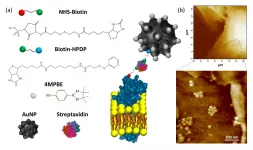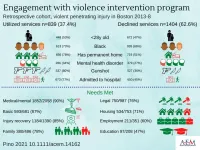Predicting success in therapy with individualized cancer models
2021-03-08
(Press-News.org) In the EU alone, 78,800 men died of prostate cancer last year. While tumors discovered at an early stage can often be completely removed by surgery and radiation therapy, the prospects of successful treatment are reduced if the cancer has further metastasized. At present, physicians cannot predict drug response or therapy resistance in patients.
Three-dimensional structures
The team led by PD Dr. Marianna Kruithof-de Julio at the Urology Research Laboratory at the Department for BioMedical Research (DBMR) of the University of Bern and Inselspital Bern, has developed a new strategy for the generation of prostate cancer organoids that can contribute to assess therapy response, their work is published in the latest issue of Nature Communications. Drs Sofia Karkampouna and Federico La Manna, the two lead co-authors of the paper, spent over one and a half year in optimizing and efficient protocol for the generation of the patient derived organoids and their detailed characterization. Moreover, in collaboration with the NEXUS Personalized Health Technologies, they have meticulously developed a medium-throughput screen for drug testing.
The researchers led by PD Dr. Kruithof-de Julio have demonstrated that patient-derived organoids retain relevant characteristics of the prostate carcinoma from which they have been originated: not only are they characterized by the same genetic mutations, but they also exhibit similar gene activity patterns.
Paving the way for personalized medicine
PD Dr. Kruithof-de Julio and her collaborators first generated a novel early stage, patient derived xenograft that is treatment naïve, then tested 74 different drugs on organoids from this and other experimental tumor models - identifying 13 compounds that reduced prostate cancer cell viability.
The researchers then tested the efficacy of these compounds on organoids from five prostate cancer patients - two with early-stage tumors and three with advanced metastatic tumors. Interestingly, among the hits ponatinib, so far approved for the treatment of leukemia, proved to be particularly effective in reduction of organoid viability and tumor growth in vivo.
However, for PD Dr. Kruithof-de Julio, the significance of these results lies not only in the drug repurposing but more importantly in promoting an approach that the medical community can undertake. "Our results pave the way for personalized medicine. In our study we only analyzed data from five patients retrospectively," says Kruithof-de Julio. "But we clearly showed that the method would be in principle feasible. Growing the organoids and drug testing can be accomplished in two weeks, a time frame that is compatible with clinical decision making. In collaboration with the Urology Department of the Inselspital, led by Prof Thalmann, we have now already been able to prove this in several cases."
"In my clinical activity, I am regularly confronted by tumors that do not respond to therapy or for which we do not know which therapy to use", says Thalmann. "This is a further step in the direction of individualized medicine, where we might be able to tailor the treatment to the tumor during the course of the disease and better understand its biology." With this approach, the researchers hope to treat patients more efficiently with less side effects and diminished costs.
INFORMATION:
[Attachments] See images for this press release:

ELSE PRESS RELEASES FROM THIS DATE:
2021-03-08
Along the western edge of Alaska's Aleutian archipelago, a group of islands that were inadvertently populated with rodents came to earn the ignominious label of the "Rat Islands." The non-native invaders were accidentally introduced to these islands, and others throughout the Aleutian chain, through shipwrecks dating back to the 1700s and World War II occupation. The resilient rodents, which are known to be among the most damaging invasive animals, adapted and thrived in the new setting and eventually overwhelmed the island ecosystems, disrupting the natural ecological order and driving out native species.
A coordinated conservation effort that removed the rats from one of the islands formerly known as Rat Island has become a new example of how ecosystems can ...
2021-03-08
Tocilizumab, an anti-inflammatory drug used to treat rheumatoid arthritis, improves outcomes in severely ill COVID-19 patients, finds the results of a new trial conducted in hospitals across India -- one of the world's most ethnically diverse countries. Researchers from the University of Bristol and Medanta Institute of Education and Research in India who led the study, published in The Lancet Respiratory Medicine, say it adds to existing evidence supporting the drug's use in critically ill patients.
Conducted in 12 public and private hospitals across India, the COVID ...
2021-03-08
Trolling and extreme levels of abuse can kill an online campaign but momentum can be maintained, and the energy and morale of exhausted activists effectively restored, by tactical retreat and taking time out, new research into the landmark 'No More Page 3' campaign in the United Kingdom shows.
Dr. Sarah Glozer of the University of Bath School of Management and Dr. Lauren McCarthy of the Royal Holloway University of London School of Business and Management studied the 'No More Page 3' campaign, which from 2012 lobbied The Sun mass-circulation newspaper to stop publishing a photo of a topless woman on page 3, a daily feature launched in 1970. Page 3, the No More Page 3 campaign argued, was a symbol of institutionalised sexism. The Sun removed the Page 3 feature ...
2021-03-08
The earliest multicellular organisms may have lacked heads, legs, or arms, but pieces of them remain inside of us today, new research shows.
According to a UC Riverside study, 555-million-year-old oceanic creatures from the Ediacaran period share genes with today's animals, including humans.
"None of them had heads or skeletons. Many of them probably looked like three-dimensional bathmats on the sea floor, round discs that stuck up," said Mary Droser, a geology professor at UCR. "These animals are so weird and so different, it's difficult to assign them to modern categories of living organisms just by looking at them, and it's not like we can extract their DNA -- we can't."
However, well-preserved fossil records ...
2021-03-08
Over 10,000 people in Europe use an assistance dog; think of guide dogs for people with a visual impairment, hearing dogs for people with a hearing impairment, medical response service dogs and psychiatric service dogs.
According to a UN-agreement and the Dutch law, these dogs are welcome in stores, hospitals and other public places. However, in practice, many assistance dog users and their dogs are regularly refused entry. In the Netherlands, four out of five assistance dog users indicate that they regularly experience problems with this.
Often, hygiene reasons are ...
2021-03-08
Researchers at the UAB have designed minimalist biostructures that imitate natural enzymes, capable of carrying out two differentiated and reversibly regulated activities thanks to a unique combination of structural and functional properties. The strategy used opens the door to the creation of "intelligent" nanomaterials with tailor-made combinations of catalytic functions.
There is an increasing interest in synthetic systems that can execute bioinspired chemical reactions without requiring the complex structures that characterise enzymes in their components. One of the most explored approaches is the self-assembly of peptides - molecules smaller than proteins - due to their biocompatibility and how their structural and functional properties can be controlled.
Researchers from the ...
2021-03-08
Several processes in the human body are regulated by biochemical reactions involving hydrogen peroxide (H2O2). Although it can act as a 'secondary messenger', relaying or amplifying certain signals between cells, H2O2 is generally toxic because of its oxidant character. The latter means that it converts (oxidizes) biochemical molecules like proteins and DNA. The oxidizing property of H2O2 is of potential therapeutic relevance for cancer, though: deliberately causing tumor cells to increase their H2O2 concentration would be a way to destroy them. In light of this, but also for monitoring pathologies associated with H2O2 overproduction, it is crucial to have a means to reliably quantify hydrogen peroxide concentrations in the extracellular environment. Now, Leonardo Puppulin ...
2021-03-08
A team of researchers from the CHUM Research Centre has identified new biomarkers associated with the severity of COVID-19 in infected patients.
Recent scientific literature has shown that the immune response plays a central part in the severity of COVID-19 disease. Understanding the immune responses generated during the course of the disease is therefore essential to determine which patients are at highest risk for serious complications and death from the disease.
In a new study published in the Journal of Clinical Investigation, scientists and clinicians led by Dr.?Catherine Larochelle, researcher at the CHUM Research Centre, have ...
2021-03-08
Bacteria integrate genetic material from other bacterial strains more easily than previously thought, which can lead to improved fitness and accelerated evolution. This is shown in a recent study by biophysicists at the University of Cologne. The team analysed genome transfer between bacteria of different lineages. The study was published in the journal PNAS.
In the experiment, the team brought one strain of bacteria into contact with DNA fragments from another strain. The uptake of foreign genetic material is known as horizontal gene transfer -- in contrast to vertical gene transfer, by which genes are inherited from a parent cell of the same lineage. The results show that ...
2021-03-08
DES PLAINES, IL - A Boston violence intervention advocacy program is effectively engaging the client population that hospital-based violence intervention programs (HVIPs) have been designed to support. This is the conclusion of a study titled Boston Violence Intervention Advocacy Program: Challenges and Opportunities for Client Engagement and Goal Achievement, to be published in the March 2021 issue of Academic Emergency Medicine (AEM), a journal of the Society for Academic Emergency Medicine (SAEM).
According to the study, HVIPs should consider which types of client needs prove most challenging to address and which novel strategies will engage vulnerable populations not typically targeted by intervention programs. ...
LAST 30 PRESS RELEASES:
[Press-News.org] Predicting success in therapy with individualized cancer models






